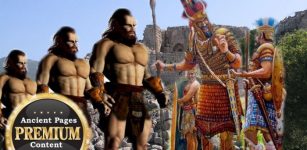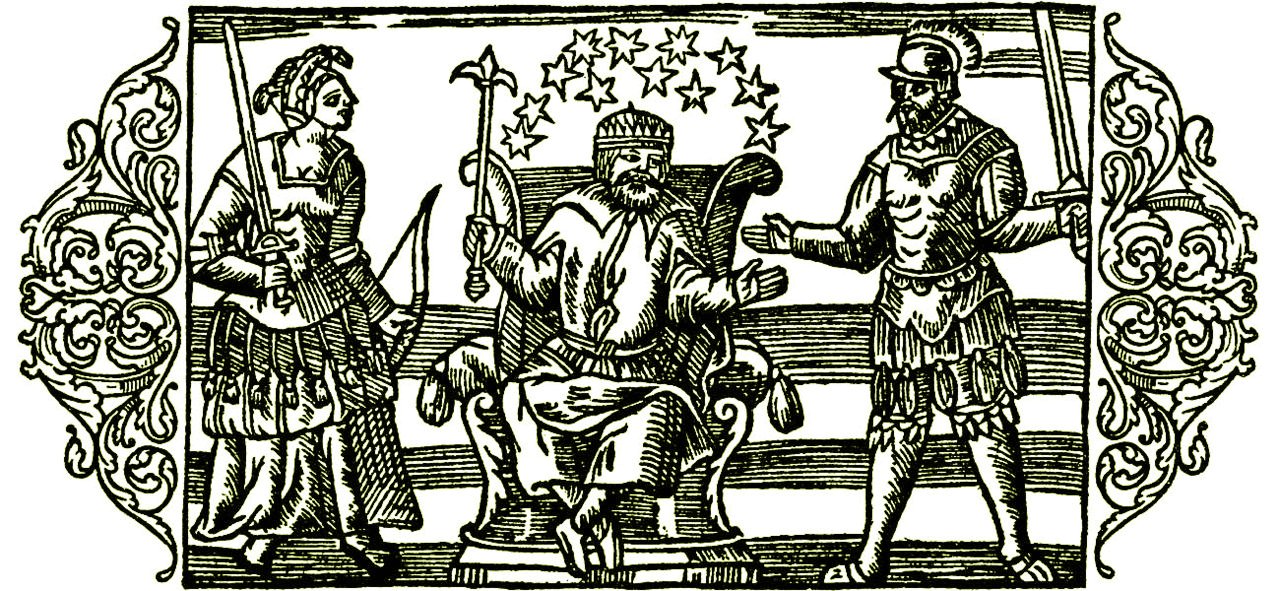The First ‘Viking’ Was A Bronze Age Man
Ellen Lloyd - AncientPages.com - The Vikings were feared, hated, and admired, and their rich history goes far back in time. Vikings changed the history of Europe, and their presence left a legacy in other parts of the world. How could they become so powerful and rich? How were they able to explore distant lands?
Credit: Stock Photo
We tend to associate Vikings with great names such as Ragnar Lodbrok, Ivar the Boneless, Erik the Red, and mighty King Harald Hardrada, just to mention a few. However, before these men became famous and influential, there was the Bronze Age that shaped the Nordic civilization and laid the foundation for the Viking Age.
Historical Studies Show The First Viking Was A Bronze Age Man
The Bronze Age was a fascinating period in Scandinavia and other parts of Europe. During this period, Norse people traded with foreign cultures and sailed to unknown lands. Influential leaders held a high status in society, and pagan gods who many believed controlled the fate of humanity were worshipped.
Around 1,600 B.C., people in northern countries quickly acquired a prominent place in Europe thanks to their trade with copper, the first metal used by ancient man more than 10,000 years ago.
Nordic people traveled all the way to the Alps and Germany to acquire copper that they transported to England in exchange for other precious metals they could bring back to their countries.
Norse deities played a vital role in society. To the left Frigg with sword and bow. In the middle Tor (Thor) with crown and spire sitting on a throne. To the right Oden (Odin) heavily armed. All these deities are encountered in Norse mythology. Credit: Public Domain
The business was booming and valuable trade contacts were established. The Norwegians played a central role in this continental trade and Jutland, a large peninsula containing Denmark's mainland regions, became the richest place in Europe. This sensational economic transformation occurred almost overnight because of trading with amber.
“I don't think the raw materials came to the Nordic countries step by step, it had become too expensive. The Norwegians must have gone a long way to get the copper, some from Central Europe, some from Spain. There are rock carvings in Portugal that are very similar to the Scandivaioan ones,” says Professor Johan Ling, at the Department of Historical Studies at the University of Gothenburg, who surveyed tens of thousands of Swedish carvings.
Trade And Colonization During The Bronze Age
The highly respected Nordic culture was undoubtedly founded on trade, but proper agriculture was also very important.
During this period, Norse people realized that investing in merchant's vessels, owning lands, trading, and looting could make them rich. This is how the Viking Age started, a period characterized by trade and colonization.
However, being a farmer could be difficult if a person doesn’t have enough land and livestock.
According to Professor Kristian Kristiansen at the Department of Historical Studies at the University of Gothenburg, Norse people created a “patrilineal society that the Indo-Europeans brought with them into Europe, where the eldest son inherits the farm. It is deeply embedded in Indo-European society and created a strong social dynamic. They also came up with a new shepherd and warrior culture, where there was the prestige of having a large herd of livestock.”
Kristiansen explained that “expansion of agriculture required unrestricted labor. If you didn't have much land, you couldn't afford to put fighters on boats. To manage agriculture and build boats for 20 people, 100 people were needed annually. This was probably not possible without slaves. During the Viking era, the vessels were considerably larger, and the need for labor increased to perhaps 250 people.”
Professor Ling explained that those who didn’t inherit large land areas gained power and wealth by becoming great warriors instead.
Boys were trained as warriors and were later sent to serve someone. In ancient times, the gender roles for boys and girls were quite defined. It was most common that boys worked on farms and girls to do housework.
Viking children at the age of 10 were considered adults and were required to learn the jobs and tasks that their parents did. The boys mainly worked on farms, and the girls worked inside like their mothers.
Viking boys were expected to learn how to take care of themselves. This meant they must be not only good farmers but also skilled warriors.
“It is a system created in the Bronze Age, where the men on the boats formed a war chest. This meant that there were basically two ways of gaining wealth: of land or of commerce and looting.
Many women came from outside, according to analyzes of remains in, among other things, Danish graves. The DNA and strontium analyses do not reveal where, only that they came from other regions. Boys were sent as foster children to an uncle's family, where they grew up with cousins and were trained in a continental network of warriors.
Gifts such as gold rings, positions of power, and women are important for alliances. It is important to be famous and remembered. The exchange of gifts is central even during the Viking era, as is evident in the Havamal life rules, but the system is formed in the Bronze Age. You see it on the rock carvings, which depict an exclusive elite with travel, hunting, and ritual matches,” Professor Ling explained.
During the Viking era, there were different classes of ships. The longships were mainly used as warships and the ships called Knarrs (or knorrs in Old Norse) served as slower passenger and cargo ships. Credit: Viking Armada by Edward Moran (1829-1901) Public Domain
One of the main reasons behind the Vikings' success in reaching distant lands lies in their remarkable longships. The Vikings’ ships were the European Dark Ages' greatest technical and artistic achievement. Without these great ships, the Viking Age would never have happened.
In a study conducted together with Professor Kristiansen and American archaeologist Timothy Earle, Professor Ling drew a comprehensive picture of the Nordic Bronze Age economy, social structures, and war ideology. The results of the study showed ships gave Norwegians power and wealth. Constructions of long-distance boats continued and played a vital role in the Vikings’ success abroad.
First version of this article was published on November 18, 2019
Written by - Ellen Lloyd – AncientPages.com
Copyright © AncientPages.com All rights reserved. This material may not be published, broadcast, rewritten or redistributed in whole or part without the express written permission of AncientPages.com
Expand for referencesMore From Ancient Pages
-
 What Were The Most Important Medieval Marketplace Rules?
Ancient History Facts | Mar 25, 2024
What Were The Most Important Medieval Marketplace Rules?
Ancient History Facts | Mar 25, 2024 -
 The Olympics In Ancient And Modern Times – What Has Changed?
Featured Stories | Jun 20, 2019
The Olympics In Ancient And Modern Times – What Has Changed?
Featured Stories | Jun 20, 2019 -
 Teutonic Knights – Facts And History About The Christian Military Order
Featured Stories | Feb 21, 2019
Teutonic Knights – Facts And History About The Christian Military Order
Featured Stories | Feb 21, 2019 -
 Ancient Cities Built By Biblical Giants – Archaeological Evidence
Biblical Mysteries | Jun 2, 2018
Ancient Cities Built By Biblical Giants – Archaeological Evidence
Biblical Mysteries | Jun 2, 2018 -
 Strange Mummies Of Venzone: Ancient Bodies That Never Decompose Remain An Unsolved Mystery
Featured Stories | Oct 22, 2018
Strange Mummies Of Venzone: Ancient Bodies That Never Decompose Remain An Unsolved Mystery
Featured Stories | Oct 22, 2018 -
 Pharaoh Ay – A Man With A Hidden Agenda Or A Victim Of Unfortunate Circumstances?
Featured Stories | Feb 5, 2019
Pharaoh Ay – A Man With A Hidden Agenda Or A Victim Of Unfortunate Circumstances?
Featured Stories | Feb 5, 2019 -
 Susanoo-no-Mikoto – Shinto God Of The Sea And Storms Was Banished From Heaven
Featured Stories | Nov 23, 2018
Susanoo-no-Mikoto – Shinto God Of The Sea And Storms Was Banished From Heaven
Featured Stories | Nov 23, 2018 -
 Controversy Of Cao Cao’s Tomb Continues – Did Archaeologists Unearth A Fake Tomb?
Civilizations | Oct 4, 2014
Controversy Of Cao Cao’s Tomb Continues – Did Archaeologists Unearth A Fake Tomb?
Civilizations | Oct 4, 2014 -
 Aslaug’s Revenge For The Death Of Ragnar Lodbrok’s Sons Eirik And Agnar
Featured Stories | Dec 10, 2018
Aslaug’s Revenge For The Death Of Ragnar Lodbrok’s Sons Eirik And Agnar
Featured Stories | Dec 10, 2018 -
 How Did Ancient People Wake Up On Time Before The Alarm Clock Was Invented?
Ancient History Facts | Jan 4, 2021
How Did Ancient People Wake Up On Time Before The Alarm Clock Was Invented?
Ancient History Facts | Jan 4, 2021 -
 Ostracism: Political Practice In Ancient Athens
Ancient History Facts | May 7, 2019
Ostracism: Political Practice In Ancient Athens
Ancient History Facts | May 7, 2019 -
 Mysterious Ancient People Who Mastered Thought-Transmission Through Space And Spoke At Distance
Featured Stories | Apr 26, 2021
Mysterious Ancient People Who Mastered Thought-Transmission Through Space And Spoke At Distance
Featured Stories | Apr 26, 2021 -
 Undeciphered Ancient Stone Maps With Mysterious Signs May Hold Key To The Spider Rock Treasure
Artifacts | Apr 29, 2014
Undeciphered Ancient Stone Maps With Mysterious Signs May Hold Key To The Spider Rock Treasure
Artifacts | Apr 29, 2014 -
 Ancient Mysteries Of Chicago: Is The Puzzling Waubansee Stone A Neglected Pre-Columbian Artifact?
Artifacts | Mar 4, 2017
Ancient Mysteries Of Chicago: Is The Puzzling Waubansee Stone A Neglected Pre-Columbian Artifact?
Artifacts | Mar 4, 2017 -
 Bizarre Sandstone Towers Of The Rocky Town And Legend Of Jan Svatos Who Mastered Magic
Featured Stories | Sep 8, 2018
Bizarre Sandstone Towers Of The Rocky Town And Legend Of Jan Svatos Who Mastered Magic
Featured Stories | Sep 8, 2018 -
 Coricancha – Stunning Golden Garden And Lost Treasures Of The Inca
Featured Stories | Aug 20, 2021
Coricancha – Stunning Golden Garden And Lost Treasures Of The Inca
Featured Stories | Aug 20, 2021 -
 Pandavleni Caves: Skillfully Carved Rocky Realms Decorated With Sculptures And Inscriptions In Brahmi Script
Featured Stories | Aug 1, 2016
Pandavleni Caves: Skillfully Carved Rocky Realms Decorated With Sculptures And Inscriptions In Brahmi Script
Featured Stories | Aug 1, 2016 -
 Chang’e: Chinese Goddess Of Moon And Immortality
Chinese Mythology | Aug 7, 2019
Chang’e: Chinese Goddess Of Moon And Immortality
Chinese Mythology | Aug 7, 2019 -
 1,500-Year-Old Marble Slab With Inscription Found On East Coast Of Sea Of Galilee
Archaeology | Dec 18, 2015
1,500-Year-Old Marble Slab With Inscription Found On East Coast Of Sea Of Galilee
Archaeology | Dec 18, 2015 -
 Dropa Stones: Did A 12,000 Year-Old Extraterrestrial Spaceship Crash On Earth?
Featured Stories | Oct 2, 2015
Dropa Stones: Did A 12,000 Year-Old Extraterrestrial Spaceship Crash On Earth?
Featured Stories | Oct 2, 2015



